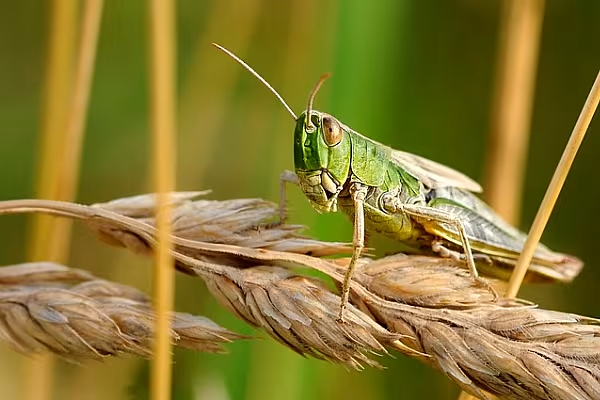Locusts breeding in central Zambia may pose a bigger threat to farmers in southern Africa than the fall armyworm that’s ravaged crops this year, according to an organization that combats the pests.
Red locusts have already reached densities of as much as 50 per square meter over 76,000 hectares (187,800 acres) in an area known as the Kafue Flats, Moses Okhoba, director of the International Red Locust Control Organization for Central and Southern Africa, said in an interview late Tuesday. If uncontrolled, they could form swarms of 40 million insects, destroying corn fields in their way.
“If you had an outbreak of locusts, the situation will be about ten times worse when compared to when you had fall armyworms,” Okhoba said in Harare, Zimbabwe’s capital. “You do not want to see a swarm of locusts in your field because then you will not be talking of anything to harvest or to see.”
50-Million Locusts
Southern African countries including Zambia, Zimbabwe and South Africa are already battling an outbreak of crop-eating caterpillars that arrived from the Americas last year. Locust swarms would be yet another setback for growers in the region, which is still recovering from the worst drought in more than 35 years. While hoppers, or larvae, have infested only 1,600 hectares of crop fields, they must be immediately stopped from expanding further, according to Okhoba.
A 50-million strong swarm of red locusts has already been found in the Itezhi Tezhi area of Central Province, about 200 kilometres west of Lusaka, Zambia’s capital, state-owned ZNBC reported on Wednesday, citing Agriculture Minister Dora Siliya. The country will notify others in the region and ask for help, as the pest could affect food security if unchecked, she said.
Emergency Meeting
A swarm of 40 million insects can eat 80,000 metric tonnes of vegetation and travel between 20 kilometres to 100 kilometres a day, depending on winds, he said, speaking on the sidelines of a regional emergency meeting to combat pests. Most farmers in southern Africa grow corn, the staple food in the region.
“At the moment the locusts are breeding in Tanzania, Malawi and Mozambique,” said Okhoba. “Outbreaks from these areas, depending on the period, can affect countries all around the region.”
Zambian President Edgar Lungu already instructed the treasury to release funds to the International Red Locust Control Organization to complete surveying and start spraying pesticides to prevent an outbreak.
News by Bloomberg, edited by ESM. Click subscribe to sign up to ESM: The European Supermarket Magazine.














